#studio de pilates
Explore tagged Tumblr posts
Note
more things you swear by?
Japanese Lingerie.
I swear by Japanese lingerie, especially if you love detailed sets. My body doesn’t suit American-made lingerie now that I’ve lost so much weight, and I learned about Japanese lingerie from r/abrathatfits on my journey to find what suited me. The bras are forward projecting and give me a much better side view. I love buying matching lingerie sets, and the sets I usually go for are lacy and intricate; they’re incredibly well priced for the quality they are, and they fit me the way I like my sets to fit me. Buying lingerie is extremely feminine to me, and I love finding sets that complement my body. I’m still not as secure in my new body as I’d like to be, and good lingerie makes me feel beautiful again.
French Tips.
French tips are my go-to. They look good, they’re low maintenance, they’re universally acceptable, and they look clean. When done right, they make my hands look longer and thinner than they are, and I love that with a thinner white line, they look and feel delicate. I mostly do French mani-pedis; it’s a habit I got into when I first went to Chicago, and it’s served me well, so I doubt I’ll ever stray from it. The nail salon combo is widely accepted to be DND865 and DND473, and I do an acrylic overlay on top of my natural nails, keep an oval shape, and request a thin tip if I’m not doing BIAB again. I won’t get into the acrylic vs. BIAB debate at the moment, but I will say that when properly done, BIAB looks amazing, is better for helping you retain length, and it lasts longer than acrylic while looking better.
Classic Makeup and Flicky Layered Hair.
I love styling my hair and doing my makeup; it’s like a reward for waking up in the morning. I get to sit down, make myself pretty, and enjoy the entire process. I figured it was time to update my skincare and makeup routines once again, so I took the time to start watching makeup tutorials (Uma Jammeh, amazing) and using what products I already have to adapt certain looks to my face. As for hair, I’m obsessed with Sarmadina de Beaute as of late and layers. I think my hair looks best with heavy, flicky layers (Remington curls) if I don’t have the time to do a blowout, and I’ve really embraced the process of both finding styling inspiration and actually doing my hair. I found my ultimate inspiration the other day, ordered hair immediately, and cut and styled one of my synthetic wigs to get the look in the interim, and I’m smitten.
Minimal Jewelry.
I’ve always worn minimal jewelry; I’m a major fan of Cartier, and I’ve curated a small collection that I wear nearly every day. I love accessorizing, but I don’t like wearing a million things that have no meaning; I prefer to only wear things I love or things that have a story behind them. Gold is my metal and diamonds are my jewel. I prefer this combo over all of the other combos I’ve seen or worn before, but I also occasionally wear mother of pearl when the time is right. I dislike being weighed down by poorly made pieces; I think jewelry can be used as a statement (when needed), and putting thought into what I wear and what I want my jewelry to say has saved me a lot of misery. With the exception of my charm necklace or lavaliere necklace, I try to wear the same sets every day.
Lymphatic Massages and Red Light Therapy.
Now that it’s November and the weather is soon to turn cold again, I’m much more focused on cardio and my diet. Because I’ve filled my weekday mornings with Pilates and my afternoons with the elliptical and stairmaster, I’ve added lymphatic drainage massages and red light therapy to my weekend schedule. I’ll be in Europe, on the slopes, in the freezing cold for the majority of my winter break, and I’m preparing for that now. Lymphatic massages are a lifesaver for me, especially during allergy season, and full-body red light therapy is just an additional benefit. I’ve also switched from studio yoga to hot yoga and from the steam room back to the sauna, stopped drinking coffee, and really started focusing on increasing my flexibility.
Tinting, Tanning, and Toning.
I love having dark skin already, but I do tend to go wild with the self-tanning in the winter. In my mind, there’s nothing more beautiful than dark skin against white snow, and the darker I am, the better I look. I grew up being told that I was too dark, but I’ve embraced it. I’m proud of my skin, and I love the richness of it, and I use tanner as a way to cover up the scarring on my body and contour my face. As for tinting, I tint my brows and lashes darker than I normally would in the colder months because they don’t turn over or fade as quickly. I never ever tint my eyebrows jet black; that color is far too harsh for my face, and I can’t pull it off at all. I use the darkest brown on my brows and jet black on my lashes. When it comes to toning, I spray my entire body with the Ordinary’s glycolic acid and let it dry after showering for the best results. I swear by it for clearing body acne and preventing any body odor.
It’s similar but different.
#richarlotte x#hypergamy#leveling up advice#leveling up tips#hypergamy advice#hypergamy tips#hypergamous heaux#hypergamous woman#black women in leisure#black women in luxury#hypergamous mindset#hypergamous lifestyle#hypergamous#leveled up mindset#leveling up#leveled up black woman#leveled up woman#spoiled black women#spoiled gf#spoiled girlfriend#becoming an it girl#spoiled heaux#becoming her#becoming that girl#it girl journey#high society advice#high society tips#social climbing#hypergamyblr#high class heaux
113 notes
·
View notes
Text
How’d They Do That?
Special Effects & Stunts of Silent Cinema - Part 1
This is the first installment of an open-ended series where I try to highlight and illustrate the work of special effects and stunt artists of silent filmdom. Using articles from contemporary fan and trade magazines, I’ll make gifs or dig up images and/or video clips to accompany the descriptions of how the sequences were executed.
My notations will be bracketed and highlighted in a different color. Hope you all enjoy! Fair warning: this is a long read.
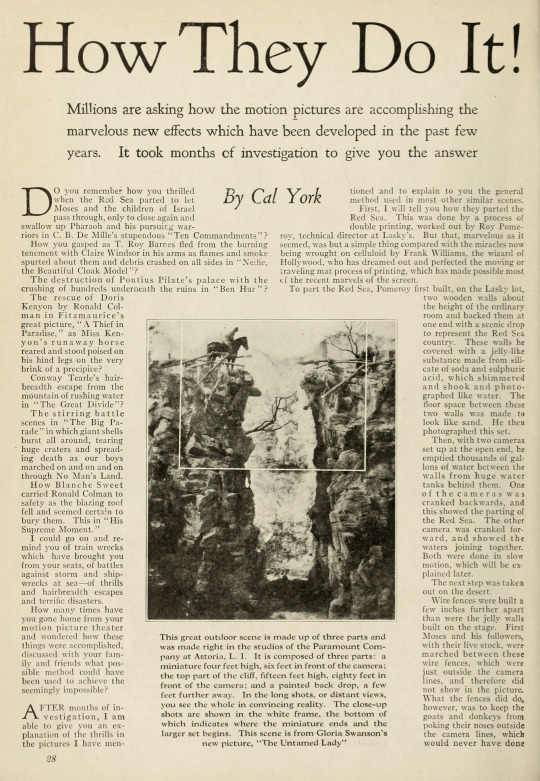
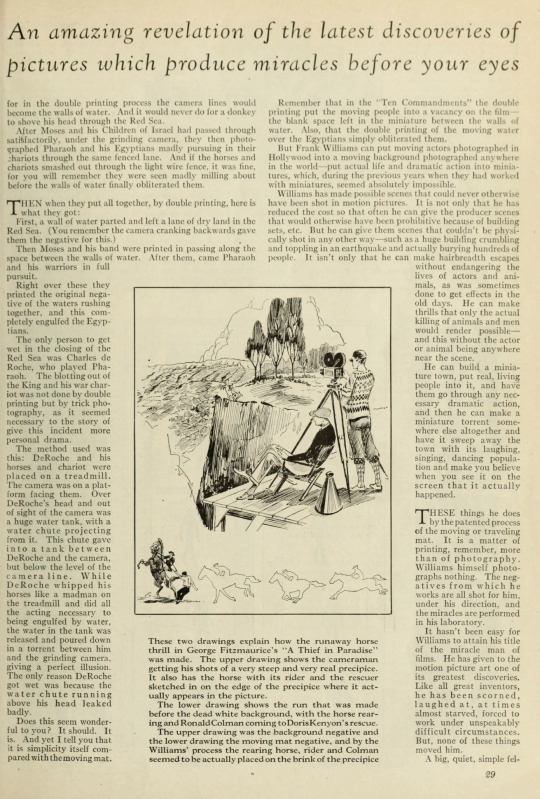
How They Do It!
[from Photoplay, April 1926]
by Cal York
Millions are asking how the motion pictures are accomplishing the marvelous new effects which have been developed in the past few years. It took months of investigation to give you the answer
DO you remember how you thrilled when the Red Sea parted to let Moses and the children of Israel pass through, only to close again and swallow up Pharaoh and his pursuing warriors in C.B. De Mille's stupendous "Ten Commandments" ?
How you gasped as T. Roy Barnes fled from the burning tenement with Claire Windsor in his arms as flames and smoke spurted about them and debris crashed on all sides in "Nellie, the Beautiful Cloak Model"?
The destruction of Pontius Pilate's palace with the crushing of hundreds underneath the ruins in "Ben Hur"?
The rescue of Doris Kenyon by Ronald Colman in Fitzmaurice's great picture, "A Thief in Paradise," as Miss Kenyon's runaway horse reared and stood poised on his hind legs on the very brink of a precipice?
Conway Tearle's hair-breadth escape from the mountain of rushing water in "The Great Divide"?
The stirring battle scenes in "The Big Parade" in which giant shells burst all around, tearing huge craters and spreading death as our boys marched on and on and on through No Man's Land.
How Blanche Sweet carried Ronald Colman to safety as the blazing roof fell and seemed certain to bury them. This in "His Supreme Moment."
I could go on and remind you of train wrecks which have brought you from your seats, of battles against storm and shipwrecks at sea—of thrills and hairbreadth escapes and terrific disasters.
How many times have you gone home from your motion picture theater and wondered how these things were accomplished, discussed with your family and friends what possible method could have been used to achieve the seemingly impossible?
AFTER months of investigation, I am able to give you an explanation of the thrills in the pictures I have mentioned and to explain to you the general method used in most other similar scenes.
First, I will tell you how they parted the Red Sea. This was done by a process of double printing, worked out by Roy Pomeroy, technical director at Lasky's. But that, marvelous as it seemed, was but a simple thing compared with the miracles now being wrought on celluloid by Frank Williams, the wizard of Hollywood, who has dreamed out and perfected the moving or traveling mat process of printing, which has made possible most of the recent marvels of the screen.
[Roy Pomeroy was head technical wizard for Famous Players-Lasky/Paramount (that is to say, he was their head special-effects engineer). We only know for certain about a handful of films that Pomeroy made specific contributions to, like The Ten Commandments (1923) and Wings (1927). As with many journeymen of the silent/studio era of Hollywood, the amount of films Pomeroy worked on was likely substantial, but many technical roles went uncredited at the time.]
To part the Red Sea, Pomeroy first built, on the Lasky lot, two wooden walls about the height of the ordinary room and backed them at one end with a scenic drop to represent the Red Sea country. These walls he covered with a jelly-like substance made from silicate of soda and sulphuric acid, which shimmered and shook and photographed like water. The floor space between these two walls was made to look like sand. He then photographed this set.

Then, with two cameras set up at the open end, he emptied thousands of gallons of water between the walls from huge water tanks behind them. One of the cameras was cranked backwards, and this showed the parting of the Red Sea. The other camera was cranked forward, and showed the waters joining together. Both were done in slow motion, which will be explained later.
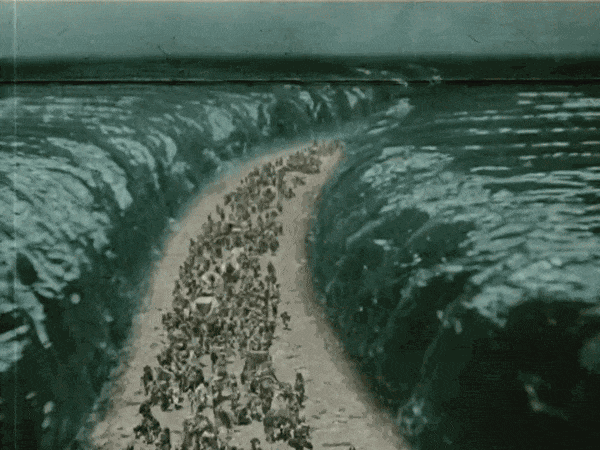
The next step was taken out on the desert.
Wire fences were built a few inches further apart than were the jelly walls built on the stage. First Moses and his followers, with their live stock, were marched between these wire fences, which were just outside the camera lines, and therefore did not show in the picture. What the fences did do, however, was to keep the goats and donkeys from poking their noses outside the camera lines, which would never have done for in the double printing process the camera lines would become the walls of water. And it would never do for a donkey to shove his head through the Red Sea.
After Moses and his Children of Israel had passed through satisfactorily, under the grinding camera, they then photographed Pharaoh and his Egyptians madly pursuing in their chariots through the same fenced lane. And if the horses and chariots smashed out through the light wire fence, it was fine. for you will remember they were seen madly milling about before the walls of water finally obliterated them.
THEN when they put all together, by double printing, here is what they got:
First, a wall of water parted and left a lane of dry land in the Red Sea. (You remember the camera cranking backwards gave them the negative for this.)
Then Moses and his band were printed in passing along the space between the walls of water. After them, came Pharaoh and his warriors in full pursuit.
Right over these they printed the original negative of the waters rushing together, and this completely engulfed The Egyptians.
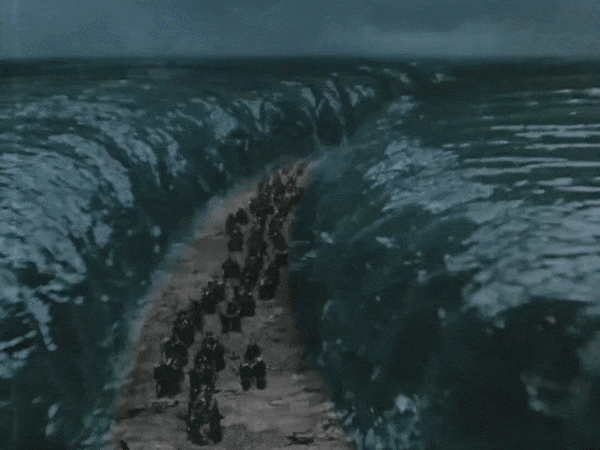
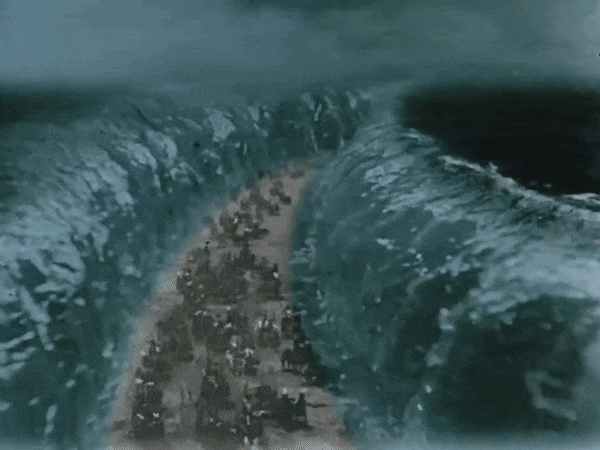
The only person to get wet in the closing of the Red Sea was Charles de Roche, who played Pharaoh. The blotting out of the King and his war chariot was not done by double printing but by trick photography, as it seemed necessary to the story of give this incident more personal drama.

The method used was this: DeRoche and his horses and chariot were placed on a treadmill. The camera was on a platform facing them. Over DeRoche's head and out of sight of the camera was a huge water tank, with a water chute projecting from it. This chute gave into a tank between DeRoche and the camera, but below the level of the camera line. While DeRoche whipped his horses like a madman on the treadmill and did all the acting necessary to being engulfed by water, the water in the tank was released and poured down in a torrent between him and the grinding camera, giving a perfect illusion. The only reason DeRoche got wet was because the water chute running above his head leaked badly.
Does this seem wonderful to you? It should. It is. And yet I tell you that it is simplicity itself compared with the moving mat.
Remember that in the "Ten Commandments" the double printing put the moving people into a vacancy on the film—the blank space left in the miniature between the walls of water. Also, that the double printing of the moving water over the Egyptians simply obliterated them.
READ ON BELOW the JUMP!
---
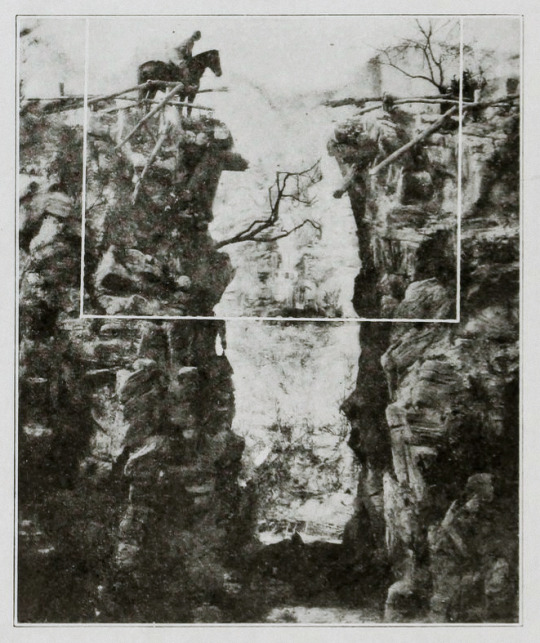
Photo caption: This great outdoor scene is made up of three parts and was made right in the studios of the Paramount Company at Astoria, L.I. It is composed of three parts: a miniature four feet high, six feet in front of the camera; the top part of the cliff, fifteen feet high, eighty feet in front of the camera; and a painted back drop, a few feet further away. In the long shots, or distant views, you see the whole in convincing reality. The close-up shots are shown in the white frame, the bottom of which indicates where the miniature ends and the larger set begins. This scene is from Gloria Swanson's new picture, "The Untamed Lady"
[The Untamed Lady (1926) is presumed lost, but luckily, a few images of this cliff-top sequence have survived.
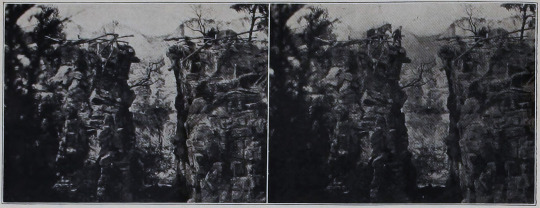
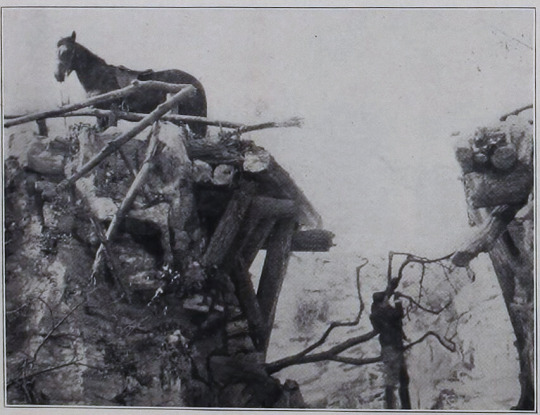
from Exhibitors Herald, 20 March 1926]
An amazing revelation of the latest discoveries of pictures which produce miracles before your eyes
---
But Frank Williams can put moving actors photographed in Hollywood into a moving background photographed anywhere in the world—put actual life and dramatic action into miniatures, which, during the previous years when they had worked with miniatures, seemed absolutely impossible.
[As you can gather from this article Frank Williams was a pioneer cinematographer and special effects artist. Williams was able to patent his moving matte process (and named it the Williams process) and it was an important effects technique used in film as as varied as Ben-Hur (1925), Sunrise: A Song of Two Humans (1926), The Lost World (1925), and The Invisible Man (1933). All of which are extant and easily accessible!
While it wasn’t in regular use for very long, the process was the basis for significant later developments in special effects photography, like green screening!]
Williams has made possible scenes that could never otherwise have been shot in motion pictures. It is not only that he has reduced the cost so that often he can give the producer scenes that would otherwise have been prohibitive because of building sets, etc. But he can give them scenes that couldn't be physically shot in any other way—such as a huge building crumbling and toppling in an earthquake and actually burying hundreds of people. It isn't only that he can make hairbreadth escapes without endangering the lives of actors and animals, as was sometimes done to get effects in the old days. He can make thrills that only the actual killing of animals and men would render possible—and this without the actor or animal being anywhere near the scene.
He can build a miniature town, put real, living people into it, and have them go through any necessary dramatic action, and then he can make a miniature torrent somewhere else altogether and have it sweep away the town with its laughing, singing, dancing population and make you believe when you see it on the screen that it actually happened.
THESE things he does by the patented process of the moving or traveling mat. It is a matter of printing, remember, more than of photography. Williams himself photographs nothing. The negatives from which he works are all shot for him, under his direction, and the miracles are performed in his laboratory.
It hasn't been easy for Williams to attain his title of the miracle man of films. He has given to the motion picture art one of its greatest discoveries. Like all great inventors, he has been scorned, laughed at, at times almost starved, forced to work under unspeakably difficult circumstances. But, none of these things moved him.
A big, quiet, simple fellow, only thirty-two years old. Shy, rather diffident of speech, he makes everything he does look easy. When he comes on a set, his quiet presence is scarcely noticed, and cameramen and technical experts go on spluttering and arguing, and when he is finally appealed to, he settles the problem so simply that everyone wonders why he didn't think of it himself.
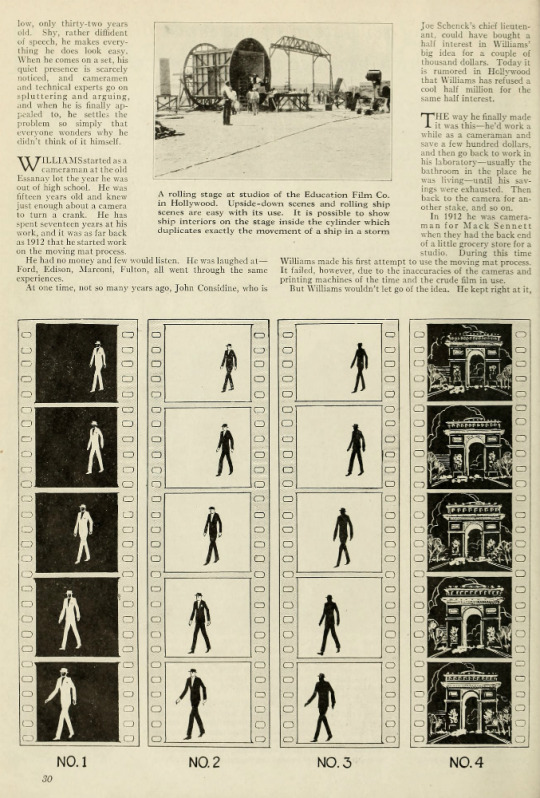
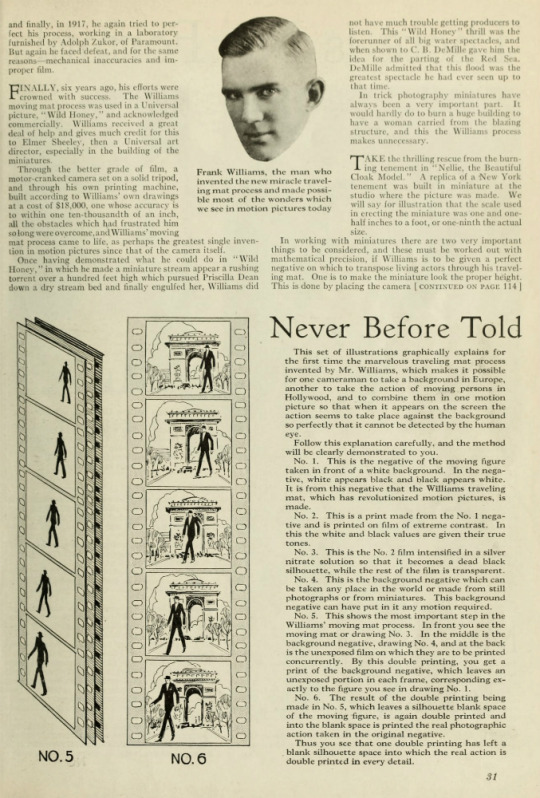
WILLIAMS started as a cameraman at the old Essanay lot the year he was out of high school. He was fifteen years old and knew just enough about a camera to turn a crank. He has spent seventeen years at his work, and it was as far back as 1912 that he started work on the moving mat process.
He had no money and few would listen. He was laughed at—Ford, Edison, Marconi, Fulton, all went through the same experiences.
At one time, not so many years ago, John Considine, who is Joe Schenck's chief lieutenant, could have bought a half interest in Williams' big idea for a couple of thousand dollars. Today it is rumored in Hollywood that Williams has refused a cool half million for the same half interest.
THE way he finally made it was this—he'd work a while as a cameraman and save a few hundred dollars, and then go back to work in his laboratory—usually the bathroom in the place he was living—until his savings were exhausted. Then back to the camera for another stake, and so on.
In 1912 he was cameraman for Mack Sennett when they had the back end of a little grocery store for a studio. During this time Williams made his first attempt to use the moving mat process. It failed, however, due to the inaccuracies of the cameras and printing machines of the time and the crude film in use.
But Williams wouldn’t let go of the idea. He kept right at it, and finally, in 1917, he again tried to perfect his process. working in a laboratory furnished by Adolph Zukor, of Paramount. But again he faced defeat, and for the same reasons—mechanical inaccuracies and improper film.
---
Photo caption: A rolling stage at studios of the Education Film Co. in Hollywood. Upside-down scenes and rolling ship scenes are easy with its use. It is possible to show ship interiors on the stage inside the cylinder which duplicates exactly the movement of a ship in a storm
[The rolling stage was used for lots of imaginative and comedic sequences in shorts and features. In the Lupino Lane short Movieland (1926), there’s a bit that shows the stage in action. Here’s a link to that specific scene, but the whole short is a lot of wacky fun and I recommend watching the full film!
Another illustration of how the rolling stage can be put to use is in When the Clouds Roll By (1919):
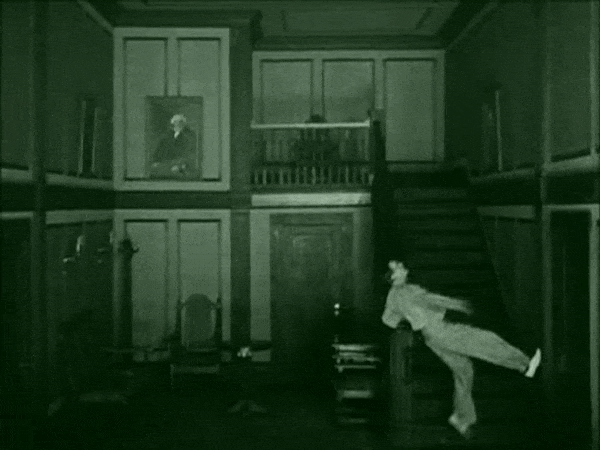

---
FINALLY, six years ago, his efforts were crowned with success. The Williams moving mat process was used in a Universal picture, "Wild Honey," and acknowledged commercially. Williams received a great deal of help and gives much credit for this to Elmer Sheeley, then a Universal art director, especially in the building of the miniatures.
Through the better grade of film, a motor-cranked camera set on a solid tripod, and through his own printing machine, built according to Williams' own drawings at a cost of $18,000, one whose accuracy is to within one ten-thousandth of an inch, all the obstacles which had frustrated him so long were overcome and Williams' moving mat process came to life, as perhaps the greatest single invention in motion pictures since that of the camera itself.
Once having demonstrated what he could do in "Wild Honey," in which he made a miniature stream appear a rushing torrent over a hundred feet high which pursued Priscilla Dean down a dry stream bed and finally engulfed her, Williams did not have much trouble getting producers to listen. This "Wild Honey" thrill was the forerunner of all big water spectacles, and when shown to C.B. DeMille gave him the idea for the parting of the Red Sea. DeMille admitted that this flood was the greatest spectacle he had ever seen up to that time.
[Unfortunately, Wild Honey (1922) is currently presumed lost and I was unable to find any depiction of Priscilla Dean fleeing from a torrent of water. As noted above however, there are quite a few extant films that also used Williams’ moving matte process.
In case you were wondering, I put $18,000 through an inflation calculator and it is equivalent to more than $315,000 in 2023 money!]
In trick photography miniatures have always been a very important part. It would hardly do to burn a huge building to have a woman carried from the blazing structure, and this the Williams process makes unnecessary.
TAKE the thrilling rescue front the burning tenement in "Nellie, the Beautiful Cloak Model." A replica of a New York tenement was built in miniature at the studio where the picture was made. We will say for illustration that the scale used in erecting the miniature was one and one-half inches to a foot, or one-ninth the actual size.
In working with miniatures there are two very important things to be considered, and these must be worked out with mathematical precision, if Williams is to be given a perfect negative on which to transpose living actors through his traveling mat. One is to make the miniature look the proper height. This is done by placing the camera the proper distance from the miniature (of course much closer than if it were a real building), and shooting from a lower level. The other is called timing. For example, if a miniature tree is to fall and the camera set-up is close enough and low enough to give the miniature the proper height when it is seen on the screen, then you must be careful of the speed with which it falls.
A little tree falls rapidly—a big tree slowly. And here is where the timing enters. Ultra speed cameras are used. The faster you crank the more pictures you get per second, and the slower the thing seems to move when you see it on the screen. You have all seen slow-motion pictures. These were made with slow-motion cameras, or what are more commonly termed ultra-speed cameras. And it is through this slow motion photography that the little tree is made to fall at the proper speed to be the big tree it represents, or the miniature stream is made to run at the proper speed for a giant river.
And so to get back to the fire which is still threatening "Our Nell." A torch is applied to the miniature tenement. At the proper count little invisible wires tied to window sashes are pulled and burning brands crash to the street below. And all the time the cameras, driven by motors at the proper speed, placed at the right distance from the conflagration and almost flat on the floor, are grinding away and recording this great fire.
[Nellie, the Beautiful Cloak Model (1924) is extant, with a print located at Gosfilmofond, but the film is not readily accessible. However, a depiction of the burning building sequence appears on an advertisement for the film:

from Film Daily, 28 February 1924]
OVER on some other part of the lot, and at any time which suits the director's convenience, T. Roy Barnes, with Miss Windsor in his arms, dashes through a black velvet door and down a street backed with more black velvet.
Two things must be remembered, however. The actors must come out of the velvet door at the right spot and at the right time or "count." This is necessary so that Williams can match up the fire negative, which is the background with action in it, with the negative of Miss Windsor and Barnes, which becomes the moving mat.
The remainder is simple, and is done by Williams and his printing process over at his laboratory.
On the screen you see Barnes dashing from a burning tenement with Miss Windsor in his arms while, in reality, neither of the actors has been close enough to a fire to singe a single eyelash.
Blanche Sweet's rescue of Colman in "The Supreme Moment" was worked out in the same manner as this, as have been most other burning building thrills in pictures made in the last few years.
[His Supreme Moment (1925) is presumed lost and unfortunately I was unable to locate a depiction of the burning building rescue mentioned here.]
Now for the destruction of Pontius Pilate's palace with the struggling mass crushed beneath, in "Ben Hur." Of course the palace was done in miniature, while the people did their acting out on the lot, where the street was built with a dead white backing. Again the timing had to correspond with that in the falling of the palace.
The throng of people was lined up and rehearsed. Two lines were drawn in the street a fixed distance apart—which represented the space where the ruins of the palace would fall, and the throng was sent dashing wildly down the street. At a fixed signal, all caught between the two marks fell flat on the ground. Those who had not reached the first line halted and registered terror. Those who had passed the second mark fled on, looking back and also registering terror. You see, those caught between the two marks were the people buried under the debris of Pilate's palace—those on either side had escaped.

Then came the trick printing with the two negatives, with considerable painting out of those who had fallen flat between the two lines, and you have the palace falling on the panic-stricken throng in the street. The accompanying drawings will help you to visualize this.
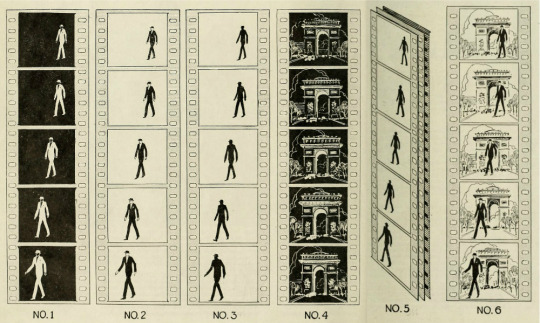
Never Before Told
This set of illustrations graphically explains for the first time the marvelous traveling mat process invented by Mr. Williams, which makes it possible for one cameraman to take a background in Europe, another to take the action of moving persons in Hollywood, and to combine them in one motion picture so that when it appears on the screen the action seems to take place against the background so perfectly that it cannot be detected by the human eye.
Follow this explanation carefully, and the method will be clearly demonstrated to you.
No. 1. This is the negative of the moving figure taken in front of a white background. In the negative, white appears black and black appears white. It is from this negative that the Williams traveling mat, which has revolutionized motion pictures, is made.
No. 2. This is a print made from the No. 1 negative and is printed on film of extreme contrast. In this the white and black values are given their true tones.
No. 3. This is the No. 2 film intensified in a silver nitrate solution so that it becomes a dead black silhouette, while the rest of the film is transparent.
No. 4. This is the background negative which can be taken any place in the world or made from still photographs or from miniatures. This background negative can have put in it any motion required.
No. 5. This shows the most important step in the Williams' moving mat process. In front you see the moving mat or drawing No. 3. In the middle is the background negative, drawing No. 4, and at the back is the unexposed film on which they are to be printed concurrently. By this double printing, you get a print of the background negative, which leaves an unexposed portion in each frame, corresponding exactly to the figure you see in drawing No. 1.
No. 6. The result of the double printing being made in No. 5, which leaves a silhouette blank space of the moving figure, is again double printed and into the blank space is printed the real photographic action taken in the original negative.
Thus you see that one double printing has left a blank silhouette space into which the real action is double printed in every detail.
---
The rescue of Doris Kenyon, which is also illustrated by the artist, was accomplished in this manner. One negative was shot of a very real and very steep precipice, the cameramen suspended on a platform far out over the edge to get the proper angle. Another negative was shot of Miss Kenyon's horse racing madly along what looked like a fence—but what was the inevitable white drop. Doris and the horse had to reach a certain mark at a certain count—for over at the precipice there had been rocks and dirt released at a certain count—the horse bad to rear, and Colman had to reach the frenzied beast, starting from outside the camera line, and he, too, must arrive on the right count. There could be no waiting for man or horse. They took it perhaps forty times before everything was exactly right, and then the two negatives (the precipice background and the moving mat) were ready for the printing wizard, and audiences got a great thrill.
[A Thief in Paradise (1925) is almost entirely lost. I profiled the film in my series Lost, but Not Forgotten in 2023.]
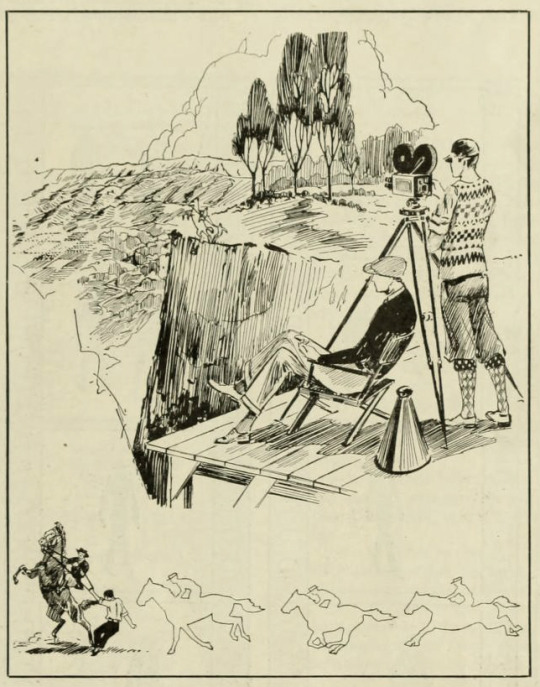
Photo caption: These two drawings explain how the runaway horse thrill in George Fitzmaurice's "A Thief in Paradise" was made. The upper drawing shows the cameraman getting his shots of a very steep and very real precipice. It also has the horse with its rider and the rescuer sketched in on the edge of the precipice where it actually appears in the picture.
The lower drawing shows the run that was made before the dead white background, with the horse rearing and Ronald Colman coming to Doris Kenyon's rescue.
The upper drawing was the background negative and the lower drawing the moving mat negative, and by the Williams' process the rearing horse, rider and Colman seemed to be actually placed on the brink of the precipice
---
You remember the mountain of water pursuing Conway Tearle in "The Great Divide." Of course they shot the torrent in miniature. Conway and his horse made their hairbreadth dash on a dark night and in an artificial rainstorm with nothing but a director threatening —then, although they did have quite a time making the steed climb a slippery and sloping wooden bridge, which was out on the back lot. Then up in Mr. Williams' laboratory, they finished one of the greatest thrills ever witnessed.
[While The Great Divide (1925) is thankfully extant at Cinemateket-Svenska Filminstitutet, it’s not easily accessible and I was unable to find a depiction of the effect.]
And the marvelous battle scenes in "The Big Parade." There were the big guns tearing huge craters in No Man's Land made on one negative, and the boys marched on and on and on in the other negative, and Mr. Williams brought them together in his printing laboratory. However, it was by no means as easy as it sounds, for this was one of the hardest pieces of moving mat printing ever accomplished.

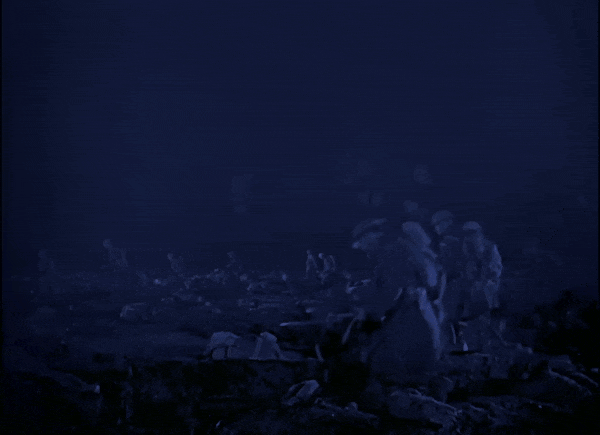

SO critical is the public that the building, photographing and printing of these miniatures must be of the very highest type of workmanship obtainable. It might be interesting to know that this work in "The Big Parade" alone cost approximately $70,000 for the background negative and the moving mat negative. The miniature battlefield was about one hundred thirty-five feet long and more than seven thousand miniature shells were fired in a period of forty seconds.
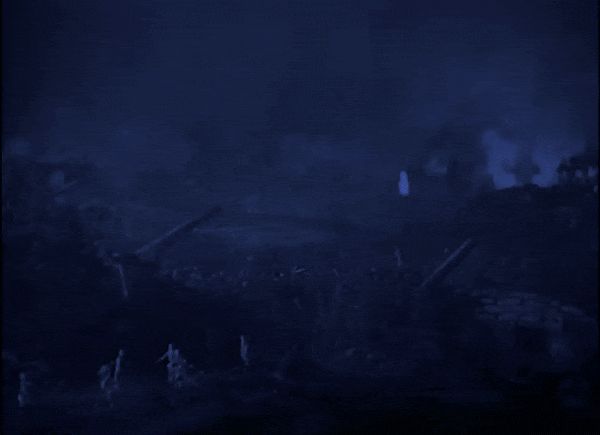



On another picture—"The Barrier"—which shows a fierce storm at sea, icebergs, and a ship caught and crushed in an ice floe, more than $85,000 have been spent to create these illusions.
[The Barrier (1926) is unfortunately presumed lost and I wasn’t able to find a depiction of this effect.]
Mr. Waller, technical camera expert of the Famous Players Long Island Studio, had never seen a cyclone; yet he was instructed to produce one for D. W. Griffith's picture, "That Royle Girl." Mr. Waller did extensive research work on the subject, and then made one to experiment with. A scientific knowledge of the working of the law of gravity, by the way, is necessary to create this phenomenon of nature.
[That Royle Girl (1925) is also presumed lost, and without film footage of this sequence there’s not really a way to know how the cyclone looked in the film. However, I do think the image highlighted in the advertisement below is likely from the cyclone sequence.
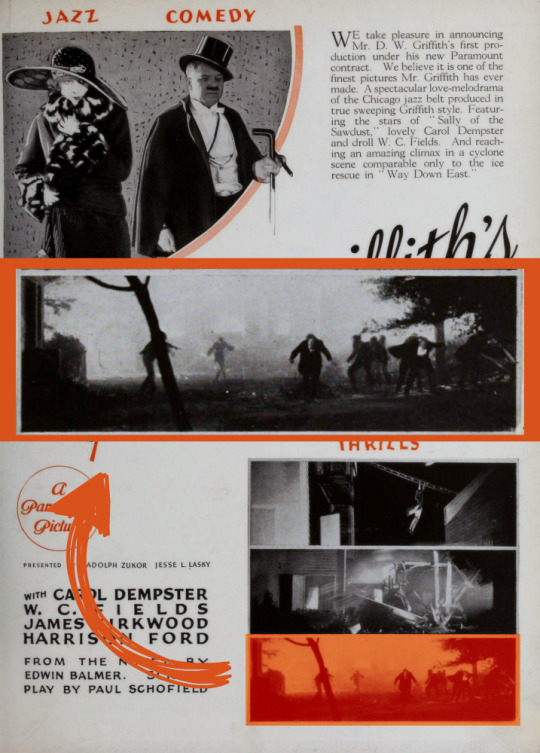
from Motion Picture News, 21 November 1925]
In the basement of the studio Mr. Waller connected up three vacuum cleaners. With three suctions of air and some dust, he made a tiny cyclone. This was photographed in slow motion so that the camera and technical crew might study the formation and activity of the cone.
From his observations of the film, Mr. Waller was able to prepare the series of wash drawings which, photographed in animated cartoon fashion, represented the action of the cyclone's cone in this sequence of the picture.
Several hundred drawings had to be made, each one depicting gradually the advance of the cone toward the Inn, which it finally demolishes. These were photographed in rotation on motion picture negative, and this negative double exposed on the 180-foot miniature scene containing the houses and trees. Thus we got a very good illusion of the cone of a cyclone advancing over a village and sweeping houses and trees out of its path.
[I wonder if/hope that some of these drawings have survived!]
The animated cartoon idea was also used in "A Kiss for Cinderella," when the pumpkin and mice change into the coach and four. The first few feet of the sequence showed real mice and pumpkin; from then on 256 wash drawings of the gradual transformation were photographed in rotation and gave the impression of being animated.

Double exposures of one actor playing two parts is the oldest and most familiar camera trick to the fans.
Just recently, however, has it been perfected to the point where the actor's two screen shadows can light each other's cigarettes and shake hands.
Tom Meighan, you recall, did this in Irish Luck."
AN invisible line from top to bottom divides each frame of the negative in half. One half at a time is exposed, photographing one half of the set.
Tom appears as Lord Fitzhugh on the left half, and as Tom Donohue on the right half. If you remember. Tom's two shadows are sitting side by side on a divan in the instance of the cigarette lighting. Fitzhugh leans over and gets a light from Donahue's cigarette. The illusion is perfect. But the cigarette from which his lordship really got the light was tacked onto a chair just outside the line, on the half of the set not being photographed at that moment. Only the lighted end of the cigarette projects into Fitzhugh's half of the picture.
[Irish Luck (1925) is extant at Eastman House, but it’s not currently easily accessible. I wasn’t able to find a depiction of this split-screen effect.]
Then when Donahue's half of the scene was being filmed, Tom leans forward and holds his cigarette in exactly the spot where the chair had been, the lighted end being outside his half of the picture. Think of the perfect matching this requires!
It is done this way. As Lord Fitzhugh performs on one side of the set, the director times his actions, counting the seconds out loud. He knows just where his lordship's right arm is, for instance, at the sixteenth second. When Donahue begins to perform on the other side of the set, his arm must be in a corresponding position at the sixteenth second. Tricky.
A thrilling moment in "Aloma of the South Seas," Gilda Grey's new picture, occurs when a shark eats a sailor. If you want this thrill, you naturally have to take it synthetic.
The shark cost $3,000. It was made of flexible rubber, and its insides consisted of a maze of electric wiring. Outside the body were several buttons which the actor could operate in his fight with the shark. It swims, wiggles its tail and bites electrically.
[Aloma of the South Seas (1926) is presumed lost and I wasn’t able to find images of the shark described here. However, as consolation, here is a photo from American Cinematographer of the film’s cinematographer Harry Fishbeck shooting on location in Puerto Rico:
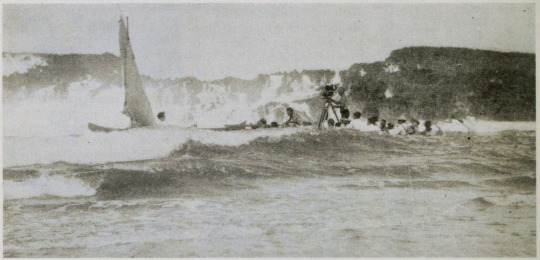
from American Cinematographer, February 1926]
I guess most of the suffering for art is done by the actors who tie themselves into knots to create the illusion of paralysis, amputated legs and so on. John Gilbert is shown in the last reels of "The Big Parade" with an amputated leg. Jack Barrymore in "The Sea Beast," also does it. It is merely a painful process of strapping the foreleg back. In "The Street of Forgotten Men," with Percy Marmont, a very lucid expose of cripple fakes is shown. Marmont had his arm strapped to his back for hours at a stretch during the filming of this picture. It hurts the first fifteen minutes, Percy said. After that the arm becomes numb.
A vigorous massage is necessary to bring it back to life, but it doesn't feel normal for weeks, Percy says.
Lon Chaney has his tricks of deformity down so pat that they are almost painless to him now.
#1920s#1910s#1926#classic film#classic movies#film#american film#my edits#silent film#my gifs#silent movies#silent era#silent cinema#cinema#film history#history#Roy Pomeroy#Frank Williams#Film Art#How'd They Do It#photoplay#lantern
63 notes
·
View notes
Text
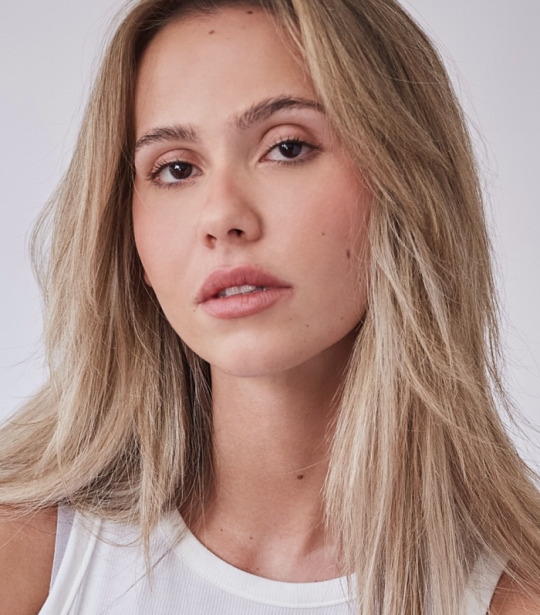
Actress "LUZ MÉNDEZ"
BIOGRAPHY:
"Luz Méndez is a talented Spanish actress who brings with her a story full of passion and sacrifice that took her from her native Tenerife to Madrid. Luz has lived in over 5 different countries, where she not only learned about different cultures, but also improved her English education. Luz is in her second year of studies at Juan Codina Studio, solidifying her acting education. However, his adventure with performing arts began much earlier, already in his childhood, when he expressed his love for acting by imitating his film heroes. Her participation in theatrical and musical works such as the emblematic Cabaret, where she stood out despite being the smallest actress, demonstrated her innate ability to slip into the skin of any character with charisma and authenticity. Luz's constant search for excellence led her to train at renowned schools such as Estudio Corazza Para La Actuación, William Layton Laboratory and Central de Cine. She perfected her skills not only in Spanish, but also in English, adding an international dimension to her acting versatility."
TRAINING :
Comedy with Juancho Calvo at Central de Cine 2023
Interpretation in Front of the Camera with Fernando Soto 2023
Preparation for Casting with Juanma López 2023
Confidence and Precision in Front of the Camera – Estudio Corazza 2022
The Character and His States Through the Text – Central de Cine 2022
Interpretation in Front of the Camera -Silber Studio Barcelona 2018-2019
Canary Islands acting school. 2004-2009
SKILLS :
Sports: Skiing, Wakeboard, Boxing, Pilates and Yoga.
LANGUAGES :
Spanish (Native), English (Bilingual) and Italian (Fluid).
<source>
7 notes
·
View notes
Text
23/05 foodlog - registers !
382 calorias - 35g de proteína !

Refeições:
Café: 2 energy drink TUM (16 cal) e trident (15 cal)
almoço: barrinha vo2 chocolate (112 cals)
Snack facul: agua de coco (44 cals)
jantar: sache de whey com café maça (175)
“Ceia”: tablete de chocolate 0 açucar que tem melatonina, para ajudar a dormir (20 cals)
hoje foi um dia ok, passei um tico mal, talvez exaustão mas foi bom, iniciei pilates em studio, primeira aula! Vou fazer 1 hora duas vezes na semana, andei 12 kms e passei o resto do meu dia na faculdade
Ps: priorizo fotos apenas das coisas com kcals, não gosto de por mais que 4 fotos só ponho se sobra e acabo pondo de chiclet e do TUM, que consumo todo dia mas saibam, smp falo, eu tomo coca zero muitos chas todos os dias
#4n@diary#4norexla#borboletana#borboletando#ed brasil#garotas bonitas não comem#ed br#ana is my friend#food log#i wanna be tiny#i wanna lose weight#ana food diary#food diary#lean lian
4 notes
·
View notes
Text
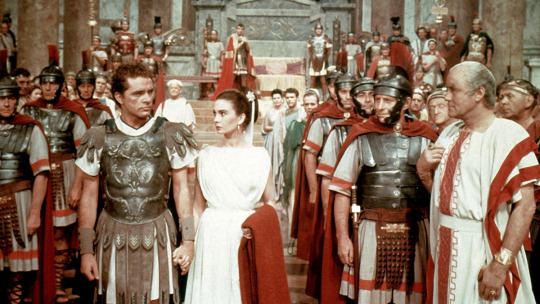
The Robe (1953)
Henry Koster’s The Robe, distributed by 20th Century Fox, appeared near the beginning of an era where religious epics and sword-and-sandal films became massive box office draws worldwide. Cecil B. DeMille’s Samson and Delilah (1949) and Mervyn LeRoy’s Quo Vadis (1951) had already laid the foundation on which Koster’s film, adapting Lloyd C. Douglas’ novel of the same name, would find its success. Despite The Robe being highly influential in Hollywood and becoming the highest-grossing film of 1953, the likes of DeMille’s The Ten Commandments (1956) and William Wyler’s Ben-Hur (1959) overtook it artistically and financially – no shame there, as those are two far superior films.
So what is The Robe’s claim to movie history beyond its initial theatrical earnings? When The Robe first came to theaters, 20th Century Fox advertised it as the first film ever made in CinemaScope. Created by Fox’s president, Spyros P. Skouras, CinemaScope was a format in which a widescreen camera lens contracted its widescreen shots onto regular 35mm film and, during theatrical projection, another lens would de-contract the image from the 35mm film in order to project a widescreen format. Theaters would only need to make minor, inexpensive modifications to their projectors in order to show a film in true CinemaScope, a 2:55:1 widescreen aspect ratio. Almost all other films were shot in the Academy ratio at the time (1.37:1, close to the 4:3 ratio – think: black bars on the left- and right-hand sides of a widescreen monitor – seen on many older standard computer monitors and televisions). With increasing competition from television, Fox executives believed CinemaScope could be a way to lure audiences back into theaters. Despite this overreaction from Fox’s executives (as well as the other major Hollywood studios), the legacy of CinemaScope’s innovation is still apparent today. Seven decades later, widescreen formats, not the Academy ratio, are the default in film and television.
Walking through the markets of Rome, returning Roman Empire tribune Marcellus Gallio (Richard Burton) reunites with his childhood sweetheart, Diana (Jean Simmons), who is now promised to Marcellus’ rival, Caligula (an always-sneering Jay Robison). Not long after, Marcellus – out of pettiness rather than financial sense – outbids Caligula for the Greek slave, Demetrius (Victor Mature). Marcellus immediately frees Demetrius, but Demetrius thinks of himself as honor-bound to stay by Marcellus. Elsewhere, an incensed Caligula reassigns Marcellus to Palestine – which, to the film’s Roman characters, might as well be the armpit of the Roman Empire. Marcellus and Demetrius go to Jerusalem, where they witness a man named Jesus enter the city, heralded by crowds of Jews greeting him with palms. Several days later, Judean Governor Pontius Pilate (Richard Boone) orders Marcellus to crucify Jesus on Calvary. Marcellus executes the order but, during and after the crucifixion, witnesses and experiences supernatural events. Demetrius, who has become a follower of Jesus during that week, obeys Marcellus when he asks him to fetch Jesus’ robe. The moment Marcellus dons the robe, he suffers something like a seizure. He falls out with Demetrius, and spends the rest of the film reckoning with his conscience over his role in Jesus’ crucifixion.
The film also stars Michael Rennie as Peter, Dean Jagger as Justus, Torin Thatcher as Senator Gallio, and Ernest Thesiger as Emperor Tiberius. Michael Ansara and Donald C. Klune are both uncredited as Judas Iscariot and Jesus, respectively.
The Robe has the misfortune of peaking in the first half. The adapted screenplay from Gina Kaus (1949’s The Red Danube), Albert Maltz (one of the blacklisted Hollywood Ten; 1950’s Broken Arrow), and Philip Dunne (1941’s How Green Was My Valley) is at its most interesting whenever Marcellus and Demetrius find themselves at odds with the other. In the scenes they share together, that happens often. But when Demetrius disappears after their disagreement over Jesus’ robe midway through, the film begins to sag with no foil for Burton to play off of.
For the entirety of this film, Richard Burton’s acting is overwrought. Burton, who had just arrived in Hollywood the year before to star in My Cousin Rachel (1952), is leaning too deeply into his theatrical roots here. His grandiose exclamations, stiff facial acting, and inconsistent line delivery result in a performance that is easily the weakest part of this film (Jean Simmons is also guilty, to a far lesser degree, of these same flaws in her performance). The Robe requires Burton’s Marcellus to undergo a spiritual conversion – becoming an adherent of Jesus despite following orders to crucify him, a developmental arc more dramatic than any other character’s in this film. Burton’s inability to convincingly sell this conversion (the stoic masculine tension, which some will interpret as coded homosexuality, between Burton’s Marcellus and Mature’s Demetrius does not help) weakens the film’s spiritual power.
Instead, it is Mature who is The Robe’s reliable scene-stealer. Mature, at one time likened to a “miniature Johnny Weissmuller”, has the classical Greek physique that, frankly, Burton does not. And in contrast to Burton at this time in their careers, Mature was more capable of a nuanced performance, as evidenced in his roles as Doc Holliday in My Darling Clementine (1946) and Nick Bianco in Kiss of Death (1947). As Demetrius, his soul hardened through his enslavement, there remains hope for a life free from the yoke of the Roman Empire and its callous slave masters. One sees it in his face during Holy Week, culminating with seeing Jesus dying on the cross. His faith is there, too, during a torture scene upon his return to Rome and an encounter with Peter. Amid miracles and cruelties, Mature’s Demetrius is simply the most compelling character of The Robe and the viewer – through Mature’s performance, especially in contrast to those of Jean Simmons and Richard Burton’s – can discern his genuine turn of faith. The Robe’s failure to showcase this inner awakening more believably is the fault of its two central actors and its screenplay; Mature’s performance and Demetrius’ characterization are all that saves the narrative.
One aspect of Christianity that The Robe captures confusingly (and oxymoronically) is the insignificance of Judea and the prominence of early Christianity in Rome in the time immediately following Jesus’ crucifixion. Oftentimes in Biblical epics, Judea is a centerpiece of the Roman Empire when, in truth (and in The Robe), it was a relative backwater. By Caligula’s reign between 37 and 41 CE, Christianity almost certainly would not have had a substantial presence in Rome at that time. So while Caligula would probably see Christianity as a threat, the film’s decision to treat the early Christians as a clear and present danger to his rule and the Roman state religion is the film’s glaring historical inaccuracy. The Robe – the book and the film – muddies the timeline from Jesus’ crucifixion to the film’s final scene in Caligula’s court. The relative suddenness of the Roman Empire seeing the early Christians as a very minor cult into becoming an Empire-wide menace is difficult to reconcile.
With few other post-silent film era Biblical epics as a guide, The Robe helps set the aesthetic of its fellow Biblical epics and sword-and-sandals movies going forward through its costumes and production design. The work of costume designers Charles LeMaire (1950’s All About Eve, 1956’s Carousel) and Emile Santiago (1952’s Androcles and the Lion, 1958’s The Big Country) is resplendent, regardless of either the Roman or Judean setting. Art directors Lyle R. Wheeler (1939’s Gone with the Wind, 1956’s The King and I) and George Davis (All About Eve, 1963’s How the West Was Won) and set decorators Walter M. Scott (All About Eve, 1965’s The Sound of Music) and Paul S. Fox (The King and I, 1963’s Cleopatra) all make full use of the CinemaScope format and color to enliven the scenery – a sumptuous visual treat for the viewer, and, to reiterate, setting a standard that the crew of The Ten Commandments and Ben-Hur both would study and surpass.
Of all of 20th Century Fox contracted stalwarts behind the camera, composer Alfred Newman was the studio’s most important figure. If Fox’s executives needed a composer to craft a score for what they would consider would be their prestige motion picture of the year, Newman – who composed the original 20th Century Fox fanfare and its CinemaScope extension (the extension, which is now inextricable from the fanfare, was first introduced in 1954’s River of No Return) – was almost always their first choice.
youtube
In one of Newman’s finest scores of his career, it is his choral compositions, with incredible help from his longtime choral supervisor Ken Darby, that form the score’s emotive spine. Jesus’ motif, shared between wordless choir and strings, appears almost immediately, in the opening seconds of the “Prelude”. During the many invocations of a Messiah before Jesus’ first physical appearance in The Robe, his motif shifts, changes form, and modulates – imparting not spiritual comfort or devotion, but a mysteriousness and otherworldliness. When Jesus (whose face we never see) first appears in Jerusalem on Palm Sunday, the cue “Passover/Palm Sunday” represents one of the rare juxtapositions of the brass-heavy martial music representing the Roman presence in Judea and Jesus himself. The modulation to a major key at 1:22 in this cue, with festive percussion, also includes one of the only instances of celebratory choral music in the score. Jesus’ motif in “Passover/Palm Sunday”, appears at 2:26 – cementing his (and Christianity’s) association with the cue, and appearing as the only instance in which one might consider this motif triumphant.
Choruses, which Western viewers so often associate in religious movies as angelic musical devices, become mournful in “The Crucifixion” – arguably the standout cue of Newman’s score. Even though one might be well aware of Jesus’ death and can anticipate a turn in the music (starting moments earlier in “The Carriage of the Cross”), it is startling to hear Newman’s composition change so rapidly. But it is in these several minutes depicting Jesus’ final moments that Newman, with modifications to his harmonies and orchestration, transforms Jesus’ motif to evoke its tragic dimensions. It is magnificent scoring from Newman, and this is not even mentioning his wonderful demarcation of Roman and Judean identities through his score.
In a film about faith – how it comforts, destroys, heals, and vexes – one wishes that the characterization of The Robe’s supposed lead characters in Marcellus and Diana could feel more plausible. The film’s final scene, possibly allegorizing of screenwriter Albert Maltz’s travails as a blacklisted figure in Hollywood, is decently powerful, but it needs far more storytelling support from numerous scenes preceding it.
As it is, the film’s expressive power lies within Demetrius and Victor Mature’s performance. So how fortunate that, because Fox also wanted to make a sequel to The Robe even before it finished production, Mature also signed a contract to appear in a sequel. Nine months after The Robe made its theatrical debut, Victor Mature starred in Demetrius and the Gladiators, directed by Delmer Daves and also seeing Michael Rennie and Jay Robinson reprise their roles as Peter and Caligula, respectively. Though it did not top the box office for that year like The Robe did, Demetrius and the Gladiators was a financial boon for Fox.
With Hollywood’s major studios always ready to respond to the box office successes of their rivals, The Robe helped make possible the decade of Biblical and sword-and-sandals epics to come – and the required viewings for many a Sunday School student in the years hence. These films were Studio System Hollywood in full maximalism, adopting human and tactile scales seldom seen today.
Yet outside of churchgoers, The Robe – for its CinemaScope and genre-specific innovations – has seen its standing slip gradually over the years, no thanks to the reputations of better movies of this tradition and, regrettably, decisions to keep 20th Century Fox’s valuable past under lock and key. 20th Century Fox’s refusal to distribute their classic films more often and more widely – before and after the studio’s 2019 takeover by the Walt Disney Company (and post-takeover, I believe the situation is now worse) – is resulting in films like The Robe slip through the proverbial cracks of film history, sights unseen for younger film buffs. That is unfortunate, especially as The Robe, almost incidentally (and no matter my aforementioned criticisms of the work itself), continues to quietly wield, by virtue of being the first CinemaScope film, a remarkable influence over cinema worldwide.
My rating: 6/10
^ Based on my personal imdb rating. My interpretation of that ratings system can be found in the “Ratings system” page on my blog. Half-points are always rounded down.
For more of my reviews tagged “My Movie Odyssey”, check out the tag of the same name on my blog.
#The Robe#Henry Koster#Richard Burton#Jean Simmons#Victor Mature#Michael Rennie#Jay Robinson#Dean Jagger#Torin Thatcher#Richard Boone#Michael Ansara#Leon Shamroy#Alfred Newman#Ken Darby#Charles LeMaire#Emile Santiago#Lyle R. Wheeler#George Davis#TCM#My Movie Odyssey
4 notes
·
View notes
Text
May 31st: Vanpool is dissolved

As per the announcement on their website, Vanpool closed its doors yesterday after over two decades of activity, and on the same day their debut project was first marketed.
The studio was founded ca. 1999 by Taro Kudo, who learned the trade as an employee for Konami, Nippon Telenet and Square, then helped establish Love-de-Lic alongside other vanpoolers, namely artist and character designer Kazuyuki Kurashima. Their first production was the 2000 PS2 cult game, Endnesia, later followed by Coloball 2002. Neither game knew any meaningful success.

Character art for Endnesia, by Kazuyuki Kurahsima (2000).
The path taken by Vanpool was quite distinct from that of Nishi's studio. Though it may have been founded on similar principles, the company survived by pivoting, at times sacrificing inventiveness in favour of more marketable ideas, published by majors.

Covers for Yoga Everywhere and Pilates Everywhere, released in 2007.
Arguably their pièce de résistance, Freshly-Picked Tingle's Rosy Rupeeland also marked the beginning of a very close relationship with Nintendo - so close, in fact, many mistook Vanpool for an external studio of theirs. Though developed under the close supervision of the Japanese giant, seen as it borrowed a peculiar character from the Zelda series, it was built on an entirely original concept proposed by Kudo himself, at least according to some sources (*). The game was not only a small success in Japan, it also fared quite reasonably overseas.

After 2009, Jun Tsuda directed the studio's last original projects, including the Japan-only sequel Irozuki Tingle no Koi no Balloon Trip, and The Rolling Western tower defence trilogy. Kudo took on the role of writer for the 3DS, WiiU and Switch Paper Mario episodes, teaming up with Intelligent Systems. In recent years, Vanpool subsisted almost exclusively through collaborations with HAL Laboratories, creators of several Kirby games, the last of which the acclaimed Switch platformer The Forgotten Land.
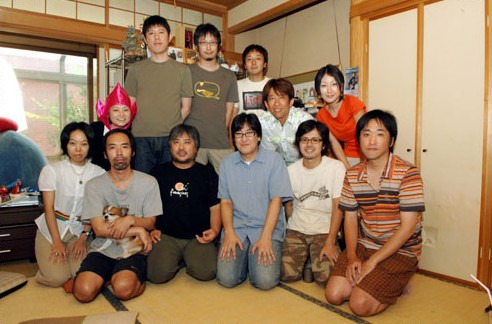
This picture dates from 2006. It was taken when the studio was hard at work producing Rosy Rupeeland. I took the liberty of adding some names for those faces I was able to recognise, having followed most of the staff on social media for several years.
My apologies if failed to identify any of them accurately.

お疲れ様でした。
(*) - The story I heard was that Kudo was highly inspired by a trip or series of trips he made to Bali in the late 90s, from which the concept for Endnesia originated. This also served as a source of inspiration for the whimsical money system in the original Tingle game. While in Indonesia, everything he saw there had a price and price tag, but the final cost was always negotiable, with shopkeepers expecting buyers to drive the number down as a natural order of things. The concept was so alien to him he decided to include and expand upon it in a game design of his own.
#vanpool#japanese game design#taro kudo#kazuyuki kurashima#jun tsuda#nintendo#intelligent systems#hal laboratory#dissolved studio#nintendo DS
11 notes
·
View notes
Text

Name: Jenny Prince From: Buffalo, NY Bio: Hi, my name is Jenny. I'm an artist and an art history professor from Buffalo, NY. I feel privileged to teach and create with you this semester. I highly value your generation and find you all incredibly inspiring.
My teaching style is based on my art history and studio art background. To truly understand and appreciate art history, one must also create art.
As an educator, I have dedicated time to researching the relationship between art history and shifts in social consciousness, particularly regarding consumerism, pop culture, and technological advancements.
As a studio artist, my experiences significantly impact the assignments I create for you. Ultimately, I want you to feel safe and welcome to celebrate and explore your individuality. Your voice matters, and I look forward to supporting your creative journey this semester.
On a personal note, I would like to share a little bit about myself. I am hoping for a Bills Super Bowl victory soon! In my free time, I love going to Pilates classes and spending quality time with my loved ones, especially if it involves great conversation over pasta and a glass of wine. I love reality TV. If a Golden Bachelor is searching for love or a Salt Lake City housewife is arguing on a yacht, I am interested.
Website: Jenny Prince (jennifereliseprince.com)
2 notes
·
View notes
Photo



Once again, there is tension in my face when there shouldn’t be. I’ve had such a nice day and the sun is shining into my bedroom window for the first time all year but I can’t get the exam fear from my mind. I think that this is because I’ve been focusing on logic today and therefore don’t feel confident with Functional Analysis or Number Theory and, worst of all, I have no visualised plan of exactly how I’m going to perfect my abilities for these two. As well as that, I did revise functional analysis this afternoon but it did a paper from a previous instructor and therefore not necessarily everything was appropriate for my course. It wasn’t a waste of time at all and it was a great re-introduction into Functional Analysis, so my clenched teeth should calm down.
Having recounted my late morning yesterday, I was once again up with the 5am sunrise today. I couldn’t help it and I did have a beautiful morning. AS standard, there was morning coffee, yoga with Adriene, and a hot shower, but unusual highlights of my morning included a Pilates class and a banana protein smoothie with breakfast. The pilates class was lovely: it felt freeing to be out of my room while doing this - rather I was in a well-lit studio with a great view of the morning sun on the maths building- but I felt like I could have done a lot more. It could have been a challenging session but the most challenging moves were for the lower abs (which I’m not willing to train while on a period).
Coming home, I did a little arm workout and truly enjoyed lateral raises, and front raises, and hammer curls, and everything really. I had a French vlog on while I was doing this, I felt proud for surrounding myself with French more frequently, and I got quite nostalgic when I saw an image of Le Jardin des Plantes.
Following that, I had an early lunch of leftover miso aubergine, some soya burger patties, a salad, and leftover spinach and pineapple smoothie. I wasn’t very hungry but the sun was inviting me outside and I wanted to go out for a walk and then revise without worrying about coming home for lunch. This turned out to be a great idea and I had a beautiful meander on my way to the Physics buidling, where I revised in one of my favourite study spots with a new friend (I wish him luck on his mechanics exam tomorrow).
I came home with hunger but enjoyed chatting with Jemima in the kitchen while I fried some basa to serve with sweet potato, cauliflower, cauliflower leaves, bulgarwheat, and red cabbage. That brings us to this exact moment, in which I have just finished my lemon and ginger tea, and I ponder what exactly I would like to leave this post to do. Having run my hands over my face in exasperation so many times today, I crave a face wash and maybe a mask. Then I think that I would like to find some revision activities for tomorrow but the only question is whether I put on pyjamas before or after that.
#That Girl#study motivation#studyblr#healthy eating#healthy diet#Food Blog#what i eat in a day#clean girl#clean eating#eat your veggies
6 notes
·
View notes
Text
4 Excellence Studio


Informações sobre o 4 Excellence Studio
O 4 Excellence Studio é um espaço de prática de exercício físico, de forma especializada e não massificada. Aumentar a condição física dos nossos alunos, inspirando-os a ser ativos e a viver as suas vidas com mais saúde, através de um conceito de treino inovador. Exclusividade, proximidade, segurança, competência e atenção aos detalhes.
Serviços
Uma experiência única em serviços de Treino Personalizado, Treino Orientado, Pilates e Pilates Clínico, em Setúbal. - Profissionais experientes e com elevado nível de formação - Ambiente exclusivo e seguro - Equipamentos de última geração - Treinos individualizados e adaptados aos seus objetivos Planos do 4 Excellence Studio Silver - Treinos Orientados (TO) - Duração: 30 minutos - Frequência: a partir de 2 vezes por semana Gold - Treinos Personalizados 30' (PT) - Frequência: 1, 2 ou 3 vezes por semana Diamond - Treinos Personalizados 45' (PT) - Frequência: 1, 2 ou 3 vezes por semana Pilates e Pilates Clínico - Aulas em pequenos grupos - Duração: 50 minutos - Frequência: 1, 2 ou 3 vezes por semana Training Pilates - Sessões de Pilates - Foco em treino funcional e fortalecimento Morada: Estrada das Machadas n.º1 Loja 1B, 2900-468 Telefone: 934 654 227 E-Mail: [email protected] Horário de funcionamento: Segunda/ Sexta: 07:00-14:00 / 16:00-20:30 Sábado: 09:00-12:00 Domingo: Encerrado Página Web | Facebook | Instagram
Fotos 4 Excellence Studio em Setúbal




Mapa 4 Excellence Studio
Se procura um estúdio de treino em Setúbal que ofereça um ambiente exclusivo, treinos personalizados e não massificados, o 4 Excellence Studio é a escolha certa para melhorar a sua condição física e bem-estar. Localizado em Setúbal, é especializado em proporcionar treinos personalizados que se adaptam aos seus objetivos, com uma abordagem focada na qualidade e atenção individual. Serviços Oferecidos: Treino Personalizado e Pilates No 4 Excellence, os serviços são projetados para proporcionar um treino personalizado e eficaz para cada cliente. Disponibilizamos planos de treino individualizados acompanhados por profissionais experientes, com sessões de 30 ou 45 minutos, uma a três vezes por semana, que garantem resultados concretos de acordo com as suas necessidades. Oferecemos ainda treino orientado em grupos pequenos de até 10 alunos, com sessões de 30 minutos, assegurando um acompanhamento especializado e a possibilidade de treinar de forma segura e motivadora. Se prefere uma abordagem mais focada no fortalecimento muscular e melhoria da postura, as nossas aulas de Pilates e Pilates Clínico são ideais, com sessões de 50 minutos em grupos pequenos, que promovem uma atenção especial às necessidades de cada aluno. Ambiente Exclusivo e Instalações Modernas O Studio destaca-se pelo seu ambiente exclusivo e seguro, com equipamentos de última geração, garantindo treinos eficazes e conforto em cada sessão. O nosso estúdio é projetado para proporcionar uma experiência diferenciada, onde cada cliente se sente valorizado e motivado a atingir os seus objetivos. Se procura privacidade e acompanhamento de qualidade, o 4 Excellence Studio é a opção perfeita em Setúbal. Horários Convenientes e Localização em Setúbal Estamos localizados na Estrada das Machadas, nº1, 2900-468 Setúbal, com horários flexíveis para se ajustar à sua rotina. O estúdio está aberto de segunda a sexta-feira das 07:00 às 14:00 e das 16:00 às 20:30, e ao sábado das 09:00 às 12:00, proporcionando a conveniência necessária para integrar o exercício físico no seu dia a dia. Experimente o 4 Excellence Studio - Transforme a Sua Vida com Treino Personalizado Se procura um estúdio de treino personalizado em Setúbal que ofereça atenção ao detalhe, profissionais qualificados e um ambiente motivador, o 4 Excellence Studio é a escolha certa. Venha experimentar uma sessão gratuita e descubra como podemos ajudá-lo a transformar a sua vida. Com foco em qualidade e resultados, somos o seu parceiro ideal na jornada para um estilo de vida saudável. 4 Excellence Studio - O Melhor Estúdio de Treino Personalizado em Setúbal para Cuidar do Seu Corpo e Mente. A atividade física no ginásio é muito mais do que um simples exercício. É um compromisso com o seu bem-estar, um investimento na sua saúde e uma oportunidade de superação. Cada treino é uma chance de melhorar a sua força, aumentar a energia e reduzir o stress do dia a dia. No ginásio 4 Excellence Studio em Setúbal, encontra a motivação certa, um ambiente que o desafia a ir mais além e o apoia a alcançar os seus objetivos, seja para ganhar massa muscular, perder peso ou simplesmente manter-se ativo e saudável. A atividade física não só melhora a sua forma física, como também contribui para a saúde mental, ajudando a combater a ansiedade e a melhorar o humor. Com o apoio de profissionais especializados, poderá seguir um plano personalizado que se adapta às suas necessidades e objetivos. A cada treino, verá os resultados surgirem, aumentando a sua confiança e auto-estima. Não espere mais para cuidar de si: no ginásio, o seu corpo e mente agradecem! Para mais informações deverá contactar o ginásio através dos contactos acima mencionados. Pratique atividade física regularmente Read the full article
0 notes
Link
0 notes
Text
Heltia Dreta de l'Eixample | Pilates y Entrenamiento Funcional

Heltia is a boutique comprehensive health centre-studio located in Dreta de l'Eixample, specialising in Pilates Reformer , Functional Training, Individualised Personal Training and Therapeutic Exercise. A new concept of Health club, with a new way of training in small groups, that takes care of you and accompanies you as you need.
With the Heltia personal training method, you are the protagonist!
The Heltia Method is for you if you have any of these goals:
• Burn fat and optimize your body composition.
• Resolve back pain and harmonize posture.
• Recover from an injury or physical ailment.
• Have a healthy lifestyle and maintain it over time.
Address: Carrer de Pau Claris, 137, Barcelona, 08009, Spain
Phone : +34 623 36 40 98
Business Email: [email protected]
Website: https://heltia.es
Connect With Us:
Heltia Dreta de l'Eixample | Pilates and Functional Training On Facebook
Heltia Dreta de l'Eixample | Pilates and Functional Training On Instagram
Heltia Dreta de l'Eixample | Pilates and Functional Training On linkedin
Heltia Dreta de l'Eixample | Pilates and Functional Training On Youtube
youtube





1 note
·
View note
Text
Finest Pilates Lessons

Reformer coaching brings a spread of benefits, including improvements in muscle energy, flexibility and posture. At an introductory level the exercises are performed slowly with precision and management, many whilst mendacity down on the carriage. This reduces influence and prevents excessive drive moving by way of vulnerable knee and hip joints - Pilates Doncaster East.
The crème de la crème de la Reformer our studio solely has space for six practitioners per class, which means you’ll get your money’s value of the teacher's consideration. Keen champions of the advantages of Reformer, Ten have taken on the Pilates approach and added their refinements together with parts from other disciplines, like circuits, weights and spin for max body-sculpting impact. Read what occurred when one WH staffer did reformer Pilates twice every week for a month. The reformer the name given to the entire platform and body utilized in reformer Pilates is probably probably the most famous piece of Pilates gear - doncaster east pilates.
The studio is air-conditioned and houses number of Pilates gear like Reformer machine, Fitness circles, Toning balls, Swiss balls, Flex bands, Pilates Chair, Cadillac etc. Another research confirmed that after twelve periods of Pilates with the reformer equipment, there have been improvements in lower again and shoulder energy. Overall, a Pilates reformer exercise is about strengthening your core and learning which muscle tissue to interact when.
With a lot bigger class size, this becomes rather tougher and it runs the chance of scholars getting injured. Pilates is a body conditioning exercise that has countless benefits, from enhancing overall health to protecting the body from accidents. Garuda exercises encapsulate the core principles of Pilates to let you entry these unbelievable advantages while working out in a modern, intelligent method. A good facet good thing about core training is that it promotes stomach strengthening. Pilates focuses on constructing your deep core muscular tissues, not simply the entrance abdominals. The advantages are you’ll get a lot of flatter stomachs and better-outlined abs. For more information, please visit our site https://pilatespower.com.au/
0 notes
Link
Pilates à domicile : La pratique où que vous soyez Vous rêvez d'un corps plus fort, plus souple et d'un bien-être accru ? Le Pilates pourrait bien être la solution idéale. Et la bonne nouvelle, c'est que vous n'avez plus besoin d'un studio pour en profiter ...
0 notes
Text
Balinese Massage Mallorca
Discover top-notch massage therapy, solo and group pilates, yoga lessons, and deep tissue massages in Mallorca, Spain. Experience professional Massage services. Balinese Massage Mallorca
Acerca de la compañía:-
I grew up in New-Zealand and the UK and lived in Japan for 24 years raising my 2 sons.As an overweight Mother at 35, I changed my diet and exercise, took up Marathon running and lost 25 kgs. Over training and injury lead me to Pilates in 2013.
I studied Stott Pilates in Tokyo, which lead me to bridging over to Balance Body Method in Malaysia and Bali. I completed and certified in all Mat and Equipment. For the past 10 years, I worked in Saudi Arabia, opening up my own client based studio then as a VIP Personal Trainer to the Princess Mashael Bin Mohamed Bint Saud al Saud for 4 years, travelling around the world with the royal family.
Haga clic aquí para más información:- https://www.massageonmallorca.com/
0 notes
Text
Smart Fit compra rede de academias Velocity por R$ 183 milhões
Objetivo é expandir a rede da companhia com a abertura de novas lojas. Unidade da Smart Fit Divulgação/Facebook Smart Fit A Smart Fit anunciou a compra da rede de academias Velocity por R$ 183 milhões. A aquisição amplia o portfólio de modalidades do segmento de Studios da companhia, que também é dona das marcas Race Bootcamp, One Pilates, Vidya, Jab House e Tonus Gym. Segundo a empresa, a…
0 notes
Text
15 juli Spanien vann..ingen spanjor att fira med..endast två danskor. Det är två par med danska tjejer och ett yngre par med kille och tjej. Vi träffar på dem på olika platser. Igår sov vi på samma ställe allihop.Sent på kvällen så kom det 2 killar, oklart nationalitet, och hade en hund med sig, en lopphög såg det ut som. Receptionisten gick hem 20 så de bara valsade in. Hunden band de fast inne i hallen. På natten vaknade jag och stretchande lite och i sängen bredvid låg plötsligt hunden. När alla hade somnat så hade han hämtat in hunden. En av de danska tjejerna hade börjat hosta och kanske var det hunden? Det luktade blöt hund i sovsalen..Hmm.
Kl 06 ringde klockan och det blev koll på vädret. Kom iväg vid 7 och då sov de andra fortfarande. Fukten hängde i luften och det blev svettigt direkt av den höga luftfuktigheten.
Vi satsade på Tamel..cirka 20 km
Tyvärr hade en allt för blöt strumpa igår orsakat en liten blåsa som jag fick tömma.

Efter ett par km var det dags för frukost på Christinas caf��.
Vi drog vidare och jag var tvungen att byta strumpor oftare, så det hela tiden var så torrt det gick. När vi satt där kom en ensam vandrare, han var från Ungern och skulle till Santiago också. Vi pratade lite om vägen och jag nämnde att det var jobbigt när stavarna fastnar mellan gatstenarna. Han sa, sätt på gummiskydden och visade sina. Jag svarade att jag inga hade. Inga problem sa han, jag har två extra, var så god. Han hängde sen på sig ryggsäcken och gjorde sig redo att gå. Han ville inte ha något betalt. Han sa bara "Kul o kunna hjälpa nån." Sen gick han. Detta skulle visa sig gjorde min dag och troligen flera dagar framöver.
I Barcelino så stannade vi för mat och plötsligt dyker ungraren upp i gränden. Vi hejade och han gick vidare.





Efter Barcelino gick vi snabbaste vägen till Tamel.
Över vattnet på en bro från 1300 talet.



Efter att vi checkat in o fått sejjos (stämplar) började bekanta droppa in. Först 2 danskor Katarina och Anne , sen 2 danskor till, i vårt rum fanns en tjeckiska Jana, sen kom en tyska Anke sen dök italienskan Katerina upp. Så vi blev 6 kända ansikten i vårt rum, kul.
När jag gick o duschade, hoppla vem dök upp då om inte ungraren. Jag förklarade för Carlos hur det gått till, han sa bara... Not surprised... Camino provides...That is how it is...
Jana såg till att vi gick ner till restaurangen över gatan.
Anke hade studerat i Lund och kunde lite svenska. Vi pratade engelska över lag annars.
Under middagen kom hospitaleron Carlos och hämtade Jana, då polisen hade kommit för identifiering av en brottare som blottat sig för Jana. Som tur var så var två av danskorna juridiska ombud åt danska polisen...ha ha ha.. vad är oddsen😎
Camino provides again..
Träffade Katarina och Anne efteråt och Polisen var nöjd med att ha fått fast den gäckande blottaren genom Janas rådiga ingripande. Polisen här tog det verkligen på allvar.
Det visade sig under middagen att alla nog skulle gå mot samma mål i morgon men olika fort och troligen olika vägval.
Katerina var Pilates instruktör och hade egen studio i italien, hon skulle gå upp redan vid 5. Hon var tidigast. Vi kom efter med 6 osv... Kanske syns vi utmed vägen också...🤔
Apropå väg... Ibland såg det ut såhär...lite peligroso...
Inte mycket att gå på...

Det skulle bli bra väder, så kanske värmen kommer i morgon...
Nu sitter jag o laddar telefonen...📲🔋
Killarna med hunden i sängen dök upp. Talade om för dem att det inte var ok att ha hund på rummet utan att först ha frågat, Carlos hörde och la sig i och var väldigt tydlig med att INGEN hund inne bland pilgrimerna.. Är någon allergisk blir det inte roligt.
0 notes